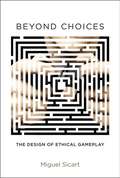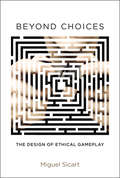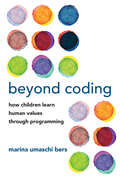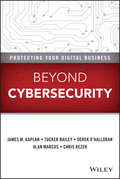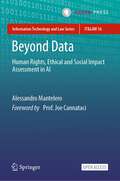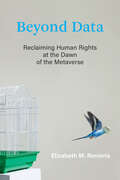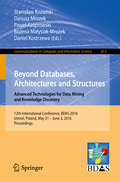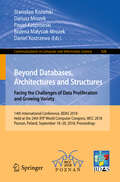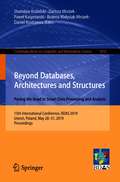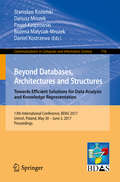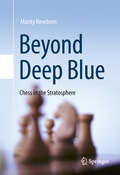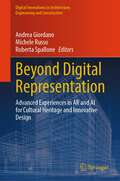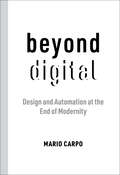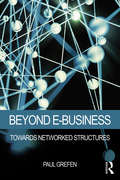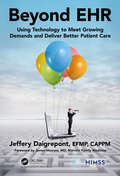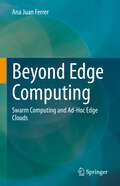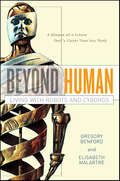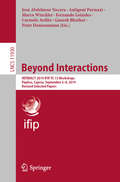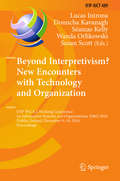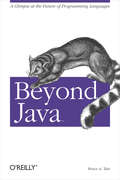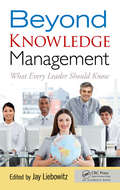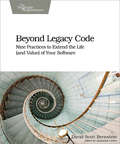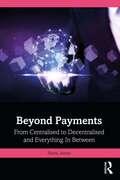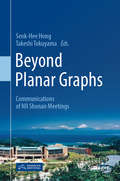- Table View
- List View
Beyond Choices
by Miguel SicartToday's blockbuster video games -- and their never-ending sequels, sagas, and reboots -- provide plenty of excitement in high-resolution but for the most part fail to engage a player's moral imagination. In Beyond Choices, Miguel Sicart calls for a new generation of video and computer games that are ethically relevant by design. In the 1970s, mainstream films -- including The Godfather, Apocalypse Now, Raging Bull, and Taxi Driver -- filled theaters but also treated their audiences as thinking beings. Why can't mainstream video games have the same moral and aesthetic impact? Sicart argues that it is time for games to claim their place in the cultural landscape as vehicles for ethical reflection.Sicart looks at games in many manifestations: toys, analog games, computer and video games, interactive fictions, commercial entertainments, and independent releases. Drawing on philosophy, design theory, literary studies, aesthetics, and interviews with game developers, Sicart provides a systematic account of how games can be designed to challenge and enrich our moral lives. After discussing such topics as definition of ethical gameplay and the structure of the game as a designed object, Sicart offers a theory of the design of ethical game play. He also analyzes the ethical aspects of game play in a number of current games, including Spec Ops: The Line, Beautiful Escape: Dungeoneer, Fallout New Vegas, and Anna Anthropy's Dys4Ia. Games are designed to evoke specific emotions; games that engage players ethically, Sicart argues, enable us to explore and express our values through play.
Beyond Choices: The Design of Ethical Gameplay (The\mit Press Ser.)
by Miguel SicartHow computer games can be designed to create ethically relevant experiences for players.Today's blockbuster video games—and their never-ending sequels, sagas, and reboots—provide plenty of excitement in high-resolution but for the most part fail to engage a player's moral imagination. In Beyond Choices, Miguel Sicart calls for a new generation of video and computer games that are ethically relevant by design. In the 1970s, mainstream films—including The Godfather, Apocalypse Now, Raging Bull, and Taxi Driver—filled theaters but also treated their audiences as thinking beings. Why can't mainstream video games have the same moral and aesthetic impact? Sicart argues that it is time for games to claim their place in the cultural landscape as vehicles for ethical reflection.Sicart looks at games in many manifestations: toys, analog games, computer and video games, interactive fictions, commercial entertainments, and independent releases. Drawing on philosophy, design theory, literary studies, aesthetics, and interviews with game developers, Sicart provides a systematic account of how games can be designed to challenge and enrich our moral lives. After discussing such topics as definition of ethical gameplay and the structure of the game as a designed object, Sicart offers a theory of the design of ethical game play. He also analyzes the ethical aspects of game play in a number of current games, including Spec Ops: The Line, Beautiful Escape: Dungeoneer, Fallout New Vegas, and Anna Anthropy's Dys4Ia. Games are designed to evoke specific emotions; games that engage players ethically, Sicart argues, enable us to explore and express our values through play.
Beyond Coding: How Children Learn Human Values through Programming
by Marina Umaschi BersWhy children should be taught coding not as a technical skill but as a new literacy—a way to express themselves and engage with the world. Today, schools are introducing STEM education and robotics to children in ever-lower grades. In Beyond Coding, Marina Umaschi Bers lays out a pedagogical roadmap for teaching code that encompasses the cultivation of character along with technical knowledge and skills. Presenting code as a universal language, she shows how children discover new ways of thinking, relating, and behaving through creative coding activities. Today&’s children will undoubtedly have the technical knowledge to change the world. But cultivating strength of character, socioeconomic maturity, and a moral compass alongside that knowledge, says Bers, is crucial. Bers, a leading proponent of teaching computational thinking and coding as early as preschool and kindergarten, presents examples of children and teachers using the Scratch Jr. and Kibo robotics platforms to make explicit some of the positive values implicit in the process of learning computer science. If we are to do right by our children, our approach to coding must incorporate the elements of a moral education: the use of narrative to explore identity and values, the development of logical thinking to think critically and solve technical and ethical problems, and experiences in the community to enable personal relationships. Through learning the language of programming, says Bers, it is possible for diverse cultural and religious groups to find points of connection, put assumptions and stereotypes behind them, and work together toward a common goal.
Beyond Cybersecurity: Protecting Your Digital Business
by Alan Marcus James M. Kaplan Tucker Bailey Derek O'Halloran Chris RezekMove beyond cybersecurity to take protection of your digital business to the next level Beyond Cybersecurity: Protecting Your Digital Business arms your company against devastating online security breaches by providing you with the information and guidance you need to avoid catastrophic data compromise. Based upon highly-regarded risk assessment analysis, this critical text is founded upon proprietary research, client experience, and interviews with over 200 executives, regulators, and security experts, offering you a well-rounded, thoroughly researched resource that presents its findings in an organized, approachable style. Members of the global economy have spent years and tens of billions of dollars fighting cyber threats—but attacks remain an immense concern in the world of online business. The threat of data compromise that can lead to the leak of important financial and personal details can make consumers suspicious of the digital economy, and cause a nosedive in their trust and confidence in online business models. Understand the critical issue of cyber-attacks, and how they are both a social and a business issue that could slow the pace of innovation while wreaking financial havoc Consider how step-change capability improvements can create more resilient organizations Discuss how increased collaboration within the cybersecurity industry could improve alignment on a broad range of policy issues Explore how the active engagement of top-level business and public leaders can achieve progress toward cyber-resiliency Beyond Cybersecurity: Protecting Your Digital Business is an essential resource for business leaders who want to protect their organizations against cyber-attacks.
Beyond Data: Human Rights, Ethical and Social Impact Assessment in AI (Information Technology and Law Series #36)
by Alessandro ManteleroThis open access book focuses on the impact of Artificial Intelligence (AI) on individuals and society from a legal perspective, providing a comprehensive risk-based methodological framework to address it. Building on the limitations of data protection in dealing with the challenges of AI, the author proposes an integrated approach to risk assessment that focuses on human rights and encompasses contextual social and ethical values. The core of the analysis concerns the assessment methodology and the role of experts in steering the design of AI products and services by business and public bodies in the direction of human rights and societal values. Taking into account the ongoing debate on AI regulation, the proposed assessment model also bridges the gap between risk-based provisions and their real-world implementation. The central focus of the book on human rights and societal values in AI and the proposed solutions will make it of interest to legal scholars, AI developers and providers, policy makers and regulators. Alessandro Mantelero is Associate Professor of Private Law and Law & Technology in the Department of Management and Production Engineering at the Politecnico di Torino in Turin, Italy.
Beyond Data: Reclaiming Human Rights at the Dawn of the Metaverse
by Elizabeth M. RenierisWhy laws focused on data cannot effectively protect people—and how an approach centered on human rights offers the best hope for preserving human dignity and autonomy in a cyberphysical world.Ever-pervasive technology poses a clear and present danger to human dignity and autonomy, as many have pointed out. And yet, for the past fifty years, we have been so busy protecting data that we have failed to protect people. In Beyond Data, Elizabeth Renieris argues that laws focused on data protection, data privacy, data security and data ownership have unintentionally failed to protect core human values, including privacy. And, as our collective obsession with data has grown, we have, to our peril, lost sight of what&’s truly at stake in relation to technological development—our dignity and autonomy as people. Far from being inevitable, our fixation on data has been codified through decades of flawed policy. Renieris provides a comprehensive history of how both laws and corporate policies enacted in the name of data privacy have been fundamentally incapable of protecting humans. Her research identifies the inherent deficiency of making data a rallying point in itself—data is not an objective truth, and what&’s more, its &“entirely contextual and dynamic&” status makes it an unstable foundation for organizing. In proposing a human rights–based framework that would center human dignity and autonomy rather than technological abstractions, Renieris delivers a clear-eyed and radically imaginative vision of the future. At once a thorough application of legal theory to technology and a rousing call to action, Beyond Data boldly reaffirms the value of human dignity and autonomy amid widespread disregard by private enterprise at the dawn of the metaverse.
Beyond Databases, Architectures and Structures. Advanced Technologies for Data Mining and Knowledge Discovery: 12th International Conference, BDAS 2016, Ustroń, Poland, May 31 - June 3, 2016, Proceedings (Communications in Computer and Information Science #613)
by Dariusz Mrozek Stanisław Kozielski Paweł Kasprowski Bożena Małysiak-Mrozek Daniel KostrzewaThis book constitutes the refereed proceedings of the 12th International Conference entitled Beyond Databases, Architectures and Structures, BDAS 2016, held in Ustroń, Poland, in May/June 2016. It consists of 57 carefully reviewed papers selected from 152 submissions. The papers are organized in topical sections, namely artificial intelligence, data mining and knowledge discovery; architectures, structures and algorithms for efficient data processing; data warehousing and OLAP; natural language processing, ontologies and semantic Web; bioinformatics and biomedical data analysis; data processing tools; novel applications of database systems.
Beyond Databases, Architectures and Structures. Facing the Challenges of Data Proliferation and Growing Variety: 14th International Conference, BDAS 2018, Held at the 24th IFIP World Computer Congress, WCC 2018, Poznan, Poland, September 18-20, 2018, Proceedings (Communications in Computer and Information Science #928)
by Dariusz Mrozek Stanisław Kozielski Paweł Kasprowski Bożena Małysiak-Mrozek Daniel KostrzewaThis book constitutes the refereed proceedings of the 14th International Conference entitled Beyond Databases, Architectures and Structures, BDAS 2018, held in Poznań, Poland, in September 2018, during the IFIP World Computer Congress.It consists of 38 carefully reviewed papers selected from 102 submissions. The papers are organized in topical sections, namely big data and cloud computing; architectures, structures and algorithms for efficient data processing; artificial intelligence, data mining and knowledge discovery; text mining, natural language processing, ontologies and semantic web; image analysis and multimedia mining.
Beyond Databases, Architectures and Structures. Paving the Road to Smart Data Processing and Analysis: 15th International Conference, BDAS 2019, Ustroń, Poland, May 28–31, 2019, Proceedings (Communications in Computer and Information Science #1018)
by Dariusz Mrozek Stanisław Kozielski Paweł Kasprowski Bożena Małysiak-Mrozek Daniel KostrzewaThis book constitutes the refereed proceedings of the 15th International Conference entitled Beyond Databases, Architectures and Structures, BDAS 2019, held in Ustroń, Poland, in May 2019. It consists of 26 carefully reviewed papers selected from 69 submissions. The papers are organized in topical sections, namely big data and cloud computing; architectures, structures and algorithms for efficient data processing and analysis; artificial intelligence, data mining and knowledge discovery; image analysis and multimedia mining; bioinformatics and biomedical data analysis; industrial applications; networks and security.
Beyond Databases, Architectures and Structures. Towards Efficient Solutions for Data Analysis and Knowledge Representation: 13th International Conference, BDAS 2017, Ustroń, Poland, May 30 - June 2, 2017, Proceedings (Communications in Computer and Information Science #716)
by Stanisław Kozielski, Dariusz Mrozek, Paweł Kasprowski, Bożena Małysiak-Mrozek and Daniel KostrzewaThis book constitutes the refereed proceedings of the 13th International Conference entitled Beyond Databases, Architectures and Structures, BDAS 2017, held in Ustroń, Poland, in May/June 2017.It consists of 44 carefully reviewed papers selected from 118 submissions. The papers are organized in topical sections, namely big data and cloud computing; artificial intelligence, data mining and knowledge discovery; architectures, structures and algorithms for efficient data processing; text mining, natural language processing, ontologies and semantic web; bioinformatics and biological data analysis; industrial applications; data mining tools, optimization and compression.
Beyond Deep Blue: Chess in the Stratosphere
by Monty NewbornMore than a decade has passed since IBM's Deep Blue computer stunned the world by defeating Garry Kasparov, the world chess champion at that time. Beyond Deep Blue tells the continuing story of the chess engine and its steady improvement. The book provides analysis of the games alongside a detailed examination of the remarkable technological progress made by the engines - asking which one is best, how good is it, and how much better can it get. Features: presents a total of 118 games, played by 17 different chess engines, collected together for the first time in a single reference; details the processor speeds, memory sizes, and the number of processors used by each chess engine; includes games from 10 World Computer Chess Championships, and three computer chess tournaments of the Internet Chess Club; covers the man-machine matches between Fritz and Kramnik, and Kasparov and Deep Junior; describes three historical matches between leading engines - Hydra vs. Shredder, Junior vs. Fritz, and Zappa vs. Rybka.
Beyond Digital Representation: Advanced Experiences in AR and AI for Cultural Heritage and Innovative Design (Digital Innovations in Architecture, Engineering and Construction)
by Andrea Giordano Michele Russo Roberta SpalloneThis book collects contributions which showcase the impact of new augmented reality (AR) and artificial intelligence (AI) technologies considered jointly in the fields of cultural heritage and innovative design. AR is an alternative path of analysis and communication if applied to several fields of research, in particular if related to space and artifacts in it. This happens because the neural network development strengthens the relationship between augmented reality and artificial intelligence, creating processes close to human thought in shorter times. In the last years, the AR/AI expansion and the future scenarios have raised a deep trans-disciplinary speculation. The disciplines of representation (drawing, surveying, visual communication), as a convergence place of multidisciplinary theoretical and applicative studies related to architecture, city, environment, tangible and intangible cultural heritage, are called to contribute to the international debate. The book chapters deal with augmented reality and artificial intelligence, analyzing their connections as research tools for knowing the environment. In particular, the topics focus on the intersection between real and virtual world and on the heuristic role of drawing in the enhancement and management of cultural heritage, in planning and monitoring the architecture, the environment, or the infrastructures. Scientists involved in AR and AI research applied separately or together in the field of cultural heritage, architectural design, urban planning, and infrastructures analysis, as well as members of public and private organizations make up interdisciplinary groups that fuel the discussion focusing on the priorities and aims of the research related to the disciplines of representation.
Beyond Digital: Design and Automation at the End of Modernity
by Mario CarpoRecasting computational design: a new modern agenda for a post-industrial, post-pandemic world.Mass production was the core technical logic of industrial modernity: for the last hundred years, architects and designers have tried to industrialize construction and standardize building materials and processes in the pursuit of economies of scale. But this epochal march of modernity is now over. In Beyond Digital, Mario Carpo reviews the long history of the computational mode of production, showing how the merger of robotic automation and artificial intelligence will stop and reverse the modernist quest for scale. Today&’s technologies already allow us to use nonstandard building materials as found, or as made, and assemble them in as many nonstandard, intelligent, adaptive ways as needed: the microfactories of our imminent future will be automated artisan shops.The post-industrial logic of computational manufacturing has been known and theorized for some time. By tracing its theoretical and technical sources, and reviewing the design theories that accompanied its rise, Carpo shows how the computational project, long under the sway of powerful antimodern ideologies, is now being recast by the urgency of the climate crisis, which has vindicated its premises—and by the global pandemic, which has tragically proven its viability. Looking at the work of a new generation of designers, technologists, and producers, Beyond Digital offers a new modern agenda for our post-industrial future.
Beyond E-Business: Towards networked structures
by Paul GrefenIn Beyond E-Business: Towards Networked Structures Paul Grefen returns with his tried and tested BOAT framework for e-business, now fully expanded and updated with the very latest overview of digitally connected business; from business models, organization structures and architecture, to information technology. What used to be termed "e-business" is now simply business as usual. Today’s successful organizations are complex; they are part of dynamic business networks built on digital channels, going far beyond traditional e-business. This text provides invaluable insights of modern e-business integrated with networked business, going much further than the usual analysis of traditional e-business texts. Included is coverage of the Big Five—social media, mobile computing, big data, cloud computing, and the internet of things --as well as service-oriented business and technology. This essential text provides a compact roadmap to networked e-business for engineering, information systems or business students as well as professionals in the field.
Beyond EHR: Using Technology to Meet Growing Demands and Deliver Better Patient Care (HIMSS Book Series)
by Jeffery P. Daigrepont, EFPM, CAPPMToday, it is not uncommon for practices and hospitals to be on their second or third EHR and/or contemplating a transition from the traditional on-premise model to a cloud-based system. As a follow-up to Complete Guide and Toolkit to Successful EHR Adoption (©2011 HIMSS), this book builds on the best practices of the first edition, fast-forwarding to the latest innovations that are currently leveraged and adopted by providers and hospitals. We examine the role that artificial intelligence (AI) is now playing in and around EHR technology. We also address the advances in analytics and deep learning (also known as deep structured or hierarchical learning) and explain this topic in practical ways for even the most novice reader to comprehend and apply. The challenges of EHR to EHR migrations and data conversions will also be covered, including the use of the unethical practice of data blocking used as a tactic by some vendors to hold data hostage. Further, we explore innovations related to interoperability, cloud computing, cyber security, and electronic patient/consumer engagement. Finally, this book will deal with what to do with aging technology and databases, which is an issue rarely considered in any of the early publications on healthcare technology. What is the proper way to retire a legacy system, and what are the legal obligations of data archiving? Though a lot has changed since the 2011 edition, many of the fundamentals remain the same and will serve as a foundation for the next generation of EHR adopters and/or those moving on to their second, third, fourth, and beyond EHRs.
Beyond Edge Computing: Swarm Computing and Ad-Hoc Edge Clouds
by Ana Juan FerrerThis book explores the most recent Edge and Distributed Cloud computing research and industrial advances, settling the basis for Advanced Swarm Computing developments. It features the Swarm computing concepts and realizes it as an Ad-hoc Edge Cloud architecture.Unlike current techniques in Edge and Cloud computing that solely view IoT connected devices as sources of data, Swarm computing aims at using the compute capabilities of IoT connected devices in coordination with current Edge and Cloud computing innovations. In addition to being more widely available, IoT-connected devices are also quickly becoming more sophisticated in terms of their ability to carry considerable compute and storage resources. Swarm computing and Ad-hoc Edge Cloud take full advantage of this trend to create on-demand, autonomic and decentralized self-managed computing infrastructures.Focusing on cognitive resource and service management, the book examines the specific research challenges of the Swarm computing approach, related to the characteristics of IoT connected devices that form the infrastructure. It also offers academics and practitioners insights for future research in the fields of Edge and Swarm computing.
Beyond Human: Living with Robots and Cyborgs
by Gregory Benford Elisabeth MalartreConcepts once purely fiction -- robots, cyborg parts, artificial intelligences -- are becoming part of everyday reality. Soon robots will be everywhere, performing surgery, exploring hazardous places, making rescues, fighting fires, handling heavy goods. After a decade or two, they will be as unremarkable as the computer screen is now in offices, airports or restaurants.Cyborgs will be less obvious. These additions to the human body are interior now, as rebuilt joints, elbows and hearts. Soon we will cross the line between repair and augmentation, probably first in sports medicine, then spreading to everyone who wants to make a body perform better, last longer, than it ordinarily could. Controversy will arise, but it will not stop the desire to live longer and be stronger than we are. Gregory Benford and Elisabeth Malartre's Beyond Human treats the landscape of human self-change and robotic development as poles of the same general phenomenon.At the Publisher's request, this title is being sold without Digital Rights Management Software (DRM) applied.
Beyond Interactions: INTERACT 2019 IFIP TC 13 Workshops, Paphos, Cyprus, September 2–6, 2019, Revised Selected Papers (Lecture Notes in Computer Science #11930)
by José Abdelnour Nocera Marco Winckler Peter Dannenmann Fernando Loizides Carmelo Ardito Antigoni Parmaxi Ganesh BhutkarThis book contains revised selected papers presented at 3 workshops held at the 17th IFIP TC 13 International Conference on Human-Computer Interaction, INTERACT 2019, which was held in September 2019 in Paphos, Cyprus. The workshops are: - Beyond Computers: Wearables, Humans, And Things - WHAT! - User Experiences and Wellbeing at Work (UX@Work) - Workshop on Handling Security, Usability, User Experience and Reliability in User-Centered Development Processes. The 12 papers included in this volume were carefully reviewed and selected from numerous submissions. They show advances in the field of HCI dealing with topics such as wearables, user experience and wellbeing at work, security, usability, user experience and reliability in user-centered development processes.
Beyond Interpretivism? New Encounters with Technology and Organization: IFIP WG 8.2 Working Conference on Information Systems and Organizations, IS&O 2016, Dublin, Ireland, December 9-10, 2016, Proceedings (IFIP Advances in Information and Communication Technology #489)
by Susan Scott Lucas Introna Donncha Kavanagh Séamas Kelly Wanda OrlikowskiThis book constitutes the refereed proceedings of the IFIP WG 8. 2 Working Conference on Information Systems and Organizations, IS&O 2016, held in Dublin, Ireland, in December 2016. The 12 revised full papers presented were carefully reviewed and selected from 75 submissions. The papers are organized in the following topical sections: doing process research; exploring affect and affordance; considering communication and performance; and examining knowledge and practice.
Beyond Java
by Bruce A. TateWhile the Java developer community is still very strong (over 44% of software developers reportedly work in the language), other languages are now drawing a greater mind share and attracting research support and developer attention. New community driven language projects are using the same development model that made Java successful. There will be more languages in the future, and one of them will eventually surpass Java in prominence. Beyond Java predicts the likely winners in that future and explains how the next generation of programming languages will win out in a non-Java- dominated world. It's a fascinating read for programmers and non-programmers alike.
Beyond Java
by Bruce A. TateBruce Tate, author of the Jolt Award-winning Better, Faster, Lighter Java has an intriguing notion about the future of Java, and it's causing some agitation among Java developers. Bruce believes Java is abandoning its base, and conditions are ripe for an alternative to emerge. In Beyond Java, Bruce chronicles the rise of the most successful language of all time, and then lays out, in painstaking detail, the compromises the founders had to make to establish success. Then, he describes the characteristics of likely successors to Java. He builds to a rapid and heady climax, presenting alternative languages and frameworks with productivity and innovation unmatched in Java. He closes with an evaluation of the most popular and important programming languages, and their future role in a world beyond Java. If you are agree with the book's premise--that Java's reign is coming to an end--then this book will help you start to build your skills accordingly. You can download some of the frameworks discussed and learn a few new languages. This book will teach you what a new language needs to succeed, so when things do change, you'll be more prepared. And even if you think Java is here to stay, you can use the best techniques from frameworks introduced in this book to improve what you're doing in Java today.
Beyond Knowledge Management: What Every Leader Should Know
by Jay LiebowitzAlthough knowledge management (KM) has already helped numerous organizations achieve competitive advantages, many organizations have yet to embark on their knowledge management journey. Geared for executives and senior managers, Beyond Knowledge Management: What Every Leader Should Know is concise and easy-to-read. It looks at 10 areas where organi
Beyond Legacy Code: Nine Practices to Extend the Life (and Value) of Your Software
by David Scott BernsteinWe're losing tens of billions of dollars a year on broken software, and great new ideas such as agile development and Scrum don't always pay off. But there's hope. The nine software development practices in Beyond Legacy Code are designed to solve the problems facing our industry. Discover why these practices work, not just how they work, and dramatically increase the quality and maintainability of any software project.These nine practices could save the software industry. Beyond Legacy Code is filled with practical, hands-on advice and a common-sense exploration of why technical practices such as refactoring and test-first development are critical to building maintainable software. Discover how to avoid the pitfalls teams encounter when adopting these practices, and how to dramatically reduce the risk associated with building software--realizing significant savings in both the short and long term. With a deeper understanding of the principles behind the practices, you'll build software that's easier and less costly to maintain and extend.By adopting these nine key technical practices, you'll learn to say what, why, and for whom before how; build in small batches; integrate continuously; collaborate; create CLEAN code; write the test first; specify behaviors with tests; implement the design last; and refactor legacy code.Software developers will find hands-on, pragmatic advice for writing higher quality, more maintainable, and bug-free code. Managers, customers, and product owners will gain deeper insight into vital processes. By moving beyond the old-fashioned procedural thinking of the Industrial Revolution, and working together to embrace standards and practices that will advance software development, we can turn the legacy code crisis into a true Information Revolution.
Beyond Payments: From Centralised to Decentralised and Everything In Between
by Neira JonesThis is a book about payments, and how they are evolving, from centralised to decentralised and everything in between, and the new opportunities they present.In the world of payments, we are experiencing an inexorable move towards decentralisation, standardisation, and automation. New business models have emerged, existing ones have evolved, and some have disappeared, whilst regulation struggles to keep pace. As the puzzle becomes more complex, each player not only needs to understand where they fit in, but how they can remain relevant in a fast-evolving and extremely competitive industry. This book takes the reader through the fundamentals of the various decentralised payment ecosystems. From blockchain to smart contracts and DeFi, jargon is debunked, and myths are busted. For each concept, a simple framework is used, enabling comparison: mechanics, economics, risks, and the future outlook. It gives the reader a unique classification framework of virtual assets and explains the regulatory landscape. Drawing on real-life examples, the book weaves together the underpinning principles, legislation, and key stakeholders.As a follow up to Understanding Payments, it is a must-have reference book for the evolution of payments. It provides practical applications, offers insights into the key disciplines, and equips anyone in the payments industry with an understanding of the key issues and opportunities.
Beyond Planar Graphs: Communications of NII Shonan Meetings
by Seok-Hee Hong Takeshi TokuyamaThis book is the first general and extensive review on the algorithmics and mathematical results of beyond planar graphs. Most real-world data sets are relational and can be modelled as graphs consisting of vertices and edges. Planar graphs are fundamental for both graph theory and graph algorithms and are extensively studied. Structural properties and fundamental algorithms for planar graphs have been discovered. However, most real-world graphs, such as social networks and biological networks, are non-planar. To analyze and visualize such real-world networks, it is necessary to solve fundamental mathematical and algorithmic research questions on sparse non-planar graphs, called beyond planar graphs.This book is based on the National Institute of Informatics (NII) Shonan Meeting on algorithmics on beyond planar graphs held in Japan in November, 2016. The book consists of 13 chapters that represent recent advances in various areas of beyond planar graph research. The main aims and objectives of this book include 1) to timely provide a state-of-the-art survey and a bibliography on beyond planar graphs; 2) to set the research agenda on beyond planar graphs by identifying fundamental research questions and new research directions; and 3) to foster cross-disciplinary research collaboration between computer science (graph drawing and computational geometry) and mathematics (graph theory and combinatorics). New algorithms for beyond planar graphs will be in high demand by practitioners in various application domains to solve complex visualization problems. This book therefore will be a valuable resource for researchers in graph theory, algorithms, and theoretical computer science, and will stimulate further deep scientific investigations into many areas of beyond planar graphs.
